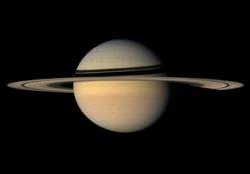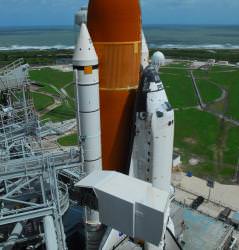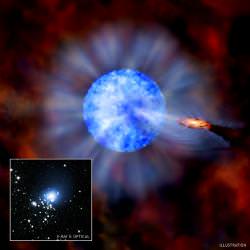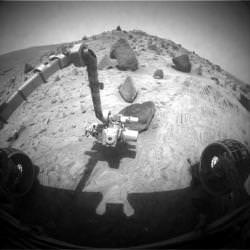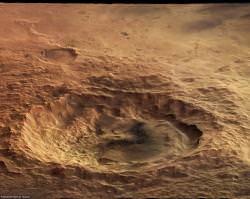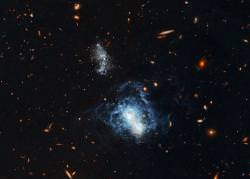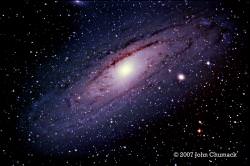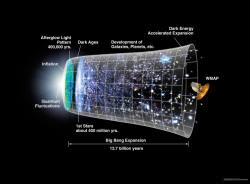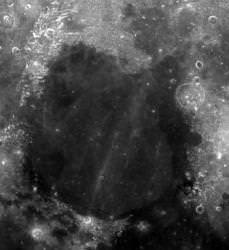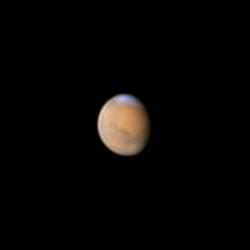Monday, October 15 – As the evening begins, be sure to at least walk out and look at the Moon. For many observers, bright red Antares will be only around a half degree north of the waxing crescent. Of course, you know that a brush this close could mean an occultation for your area! Be sure to check IOTA for visibility locations and times. No special equipment is needed to check out a lunar occultation, but thanks to an historic observation of just such an event, Antares’ companion star was discovered by Professor Johannes Burg in Vienna on April 13, 1819!
Today in 1963 marks the first detection of an interstellar molecule. This discovery was made by Sander Weinreb (with Barrett, Meeks, and Henry) on the MIT Millstone Hill 84-foot dish. The discovery was made possible by new correlation receiver technology, and picked up a hydroxyl molecule in an absorption band. By using the radio galaxy Cas A as a background continuum source, the detection occurred at 1667.46 MHz and again at 1665.34 MHz. By the dawn of 2000, nearly 200 different interstellar molecules had been identified and many of these are classified as organic.
Tonight let’s have a look at a radio source as we visit a pulsar located almost mid-way between Theta and Beta Capricorni – PSR2045+16.
While pulsars aren’t truly visible objects, there is still something undeniably cool about locating the field in which a rotating neutron star is sending out staccato pulses of radio waves anywhere between .001 and 4 seconds apart. If you have bright star 19 in the binocular field, then you know you’re in the right area for many radio sources, including many nearby quasars… Just imagine the possibilities!
Tuesday, October 16 – Do you remember Professor Burg who discovered Antares’ companion during an occultation? Then tonight let’s have a look at the crater named for him as we begin by using past study crater Posidonius as our guide.
If you walk along the terminator to the northwest, you’ll see the punctuation of 40 kilometer-wide Burg just emerging from the shadows. While it doesn’t appear to be a grand crater like Posidonius, it has a redeeming feature: it’s deep – real deep. If Burg were filled with water here on Earth, it would require a deep submergence vehicle like ALVIN to reach its 3680 meter floor! This class II crater stands fairly alone on an expanse of lunarscape known as Lacus Mortis. If the terminator has advanced enough at your time of viewing, you may be able to see this walled plain’s western boundary peeking out of the shadows.
Now let’s drop south-southeast of Beta Capricorni to have a look at a pair of doubles – Rho and Pi.
Northernmost Pi is a multiple system slightly less than 100 light-years away, with each discernable member also being a spectroscopic double. Separated by about an eighth of a light-year, look for a 5th magnitude yellow/white giant with a very close 9th magnitude companion. Further south is Pi, a triple star system which has a traditional name – Okul. Located around 670 light-years away, look for a bright blue/white 5th magnitude primary that is also a spectroscopic double – and its much easier C component, which is around magnitude 8.
Wednesday, October 17 – Tonight let’s start with the Moon and explore a binocular curiosity.
Look on the northeast shore of Mare Serenitatis for the bright ring of Posidonius, which contains several equally bright points both around and within it. Now look at Mare Crisium and get a feel for its size. A little more than one Crisium’s length west of Posidonius you’ll meet Aristotle and Eudoxus. Drop a similar length south and you will be at the tiny, bright crater Linne on the expanse of Mare Serenitatis. So what’s so cool about this little white dot? With only binoculars you are resolving a crater that is one mile wide, in a seven mile wide patch of bright ejecta from close to a quarter of a million miles away!
Now point those binoculars towards the northwestern corner of Capricornus and have a look a spectacular Alpha!
Although the Alpha 1 and 2 pairing is strictly a visual binary, that won’t stop you from enjoying their slightly yellow and orange colors. Collectively they are named Al Giedi, and the brighter of the pair is Alpha 2 at about 100 light-years distant; while Alpha 1 is around five times further away. Now power up with a telescope and you’ll find that both stars are also visual doubles! While the companion stars to both are around the same magnitude, you’ll find that Alpha 2 is separated by three times as much distance. Be sure to mark your observation lists and enjoy!
Thursday, October 18 – Today in 1959, Soviet Luna 3 began returning the first photographs of the Moon’s far side. Also today – but in 1967 – the Soviets again made history as Venera 4 became the first spacecraft to probe Venus’ atmosphere. If you’re up before dawn, be sure to have a look at brilliant Venus pairing with the solemn Saturn. You’ll find them just a few fingerwidths apart!
Tonight let’s walk on the Moon and check off a few more features on your lunar list! Look for the prominent pair of Aristillus and Autolycus caught just east of the Apennine Mountain range. If you haven’t logged the shallow Archimedes, tonight is your chance. Take the time to closely inspect the differing lava flow patterns on the floor of Palus Putredinus – and you can’t miss the bright ring of Manilius!
When we’re done? Let’s go have a look at Gamma Aquilae just for the heck of it. Just northwest of bright Altair, Gamma has the very cool name of Tarazed and is believed to be over 300 light-years away. This K3 type giant will show just a slightly yellow coloration – but what really makes this one special is the low power field!
Friday, October 19 – Our lunar mission for tonight is to move south past the crater rings of Ptolemaeus, Alphonsus, Arzachel and Purbach until we end up at the spectacular crater Walter. Named for Dutch astronomer Bernhard Walter, this 132 by 140 kilometer-wide lunar feature offers up amazing details at high power. Perhaps amongst the most fascinating is to take the time to study the differing levels, which drop to a maximum of 4130 meters below the surface. Multiple interior strikes abound, but the most fascinating of all is the wall crater Nonius. Spanning 70 kilometers, Nonius would also appear to have a double strike of its own – one that’s 2990 meters deep!
Now, let’s go have a look at the northeastern corner of Capricornus as we learn about Delta…
Its proper name is Deneb Algedi and this nearly 3rd magnitude star is a stunning blue/ white. Curiously enough, it’s a rather close star – only about 50 light-years from Earth. Hovering so close to it that we cannot even correctly assess its spectral type is a binary companion whose eclipsing orbit causes Delta to be a very slight variable – with a period of just about one day. In its own way, Delta is rather historic… For it was only 4 degrees north of this star that Uranus was first sighted by Galle in 1846!
Saturday, October 20 – It’s bold. It’s beautiful. You’ve looked at it hundreds of times…and tonight? It’s Copernicus…
While Copernicus is not the oldest, deepest, largest, or brightest crater on the Moon, it certainly is one of the most detailed. Visible in binoculars toward Plato and near the terminator, this youthful crater gives a highly etched appearance. Its location in a fairly smooth plain near the center of the Moon’s disc, and its prominent “splash” ray system, all combine to make Copernicus visually stunning in a small telescope.
Spanning 100 kilometers in diameter, with 23 kilometer thick walls, the “Mighty One” is most definitely an impact crater that left its impression down to 3840 meters below the surface. Geologist Gene Shoemaker cited many features of Copernicus which mirror our own terrestrial impact features. Many of these Copernican features could have been caused by a large meteoritic body…a body about the size of Comet Halley’s nucleus. No matter what optical aid you use, mid-placed Copernicus simply rocks!
Now we are slipping into the stream of Comet Halley and into one of the finest meteor showers of the year. If skies are clear tonight, this would be the perfect chance to begin your observations of the Orionid meteor shower. But go to bed early… And wait for the Moon to set!
Sunday, October 21 – Be sure to be outdoors before dawn to enjoy one of the year’s most reliable meteor showers. The offspring of Comet Halley will grace the early morning hours as they return once again as the Orionid meteor shower. This dependable shower produces an average of 10-20 meteors per hour at maximum and the best activity begins before local midnight on the 20th, and reaches its best as Orion stands high to the south at about two hours before local dawn on the 21st. With the Moon nearly out of the picture, this is gonna be great!
Although Comet Halley has long since departed our Solar System, the debris left from its trail still remain scattered in Earth’s orbital path around the Sun, allowing us to predict when this meteor shower will occur. We first enter the “stream” at the beginning of October and do not leave it until the beginning of November, making your chances of “catching a falling star” even greater! These meteors are very fast, and although they are faint, it is still possible to see an occasional fireball that leaves a persistent trail.
For best success, try to get away from city lights. Facing south-southeast, simply relax and enjoy the stars of the winter Milky Way. The radiant, or apparent point of origin, for this shower will be near the red giant Alpha Orionis (Betelguese), but meteors may occur from any point in the sky. You will make your meteor watching experience much more comfortable if you take along a lawn chair, a blanket and a thermos of your favorite beverage.
Clouded out? Don’t despair. You don’t always need your eyes or perfect weather to meteor watch. By tuning an FM radio to the lowest frequency possible that does not receive a clear signal, you can practice radio meteor listening! An outdoor FM antenna pointed at the zenith and connected to your receiver will increase your chances, but it’s not necessary. Simply turn up the static and listen. Those hums, whistles, beeps, bongs, and occasional snatches of signals are our own radio signals being reflected off the meteor’s ion trail!
Pretty cool, huh?

